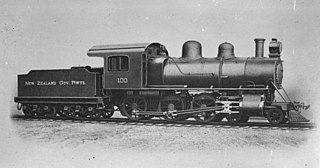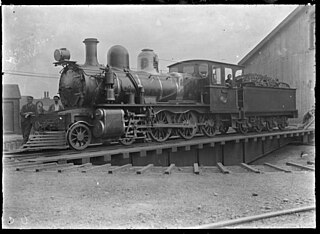Oamaru locomotive dumpsite
By 1930, New Zealand Railways was facing issues with erosion of the Oamaru railway yard by breakers from the Pacific Ocean. Despite the construction of a mole to make the Oamaru harbour more suitable for shipping, this provided no protection for the railway land. As NZR had withdrawn a number of obsolete steam locomotives and scrap prices were low, the decision was made to dump some of these locomotives at Oamaru as erosion control.
The dumpsite was well known to railway enthusiasts, who would visit the site at low tide to view the remains of the locomotives. In 2002, enthusiast Tony Bachelor salvaged the remains of Brooks UB 17 and 1898-built Baldwin UB 282 for his Hooterville Charitable Steam Trust. Due to Hooterville's closure in 2005, the locomotives have since languished on the site of the old Waitara railway yards and are visible from Johnstone Street, Waitara.
In 2008 the dumpsite was threatened again by the sea, and OnTrack began work in June of that year to shore the bank back up. As a part of this, most of the remains of the dump site were removed from the foreshore with some handed over to the Oamaru Steam and Rail Restoration Society for safekeeping. Today the dump site is largely non-existent although the remains of at least 1 Canterbury J Class engine is still in place on the foreshore, having never been recovered for an unknown reason.

Railway preservation in New Zealand is the preservation of historically significant facets of New Zealand's rail transport history. The earliest recorded preservation attempt took place in 1925, although the movement itself did not start properly until 1960.

The Bealey River is a small river located in the Southern Alps of New Zealand. It is a tributary of the Waimakariri River. Its valley forms the eastern approach to Arthur's Pass. The river and the Bealey settlement are named for Samuel Bealey, a 19th-century Superintendent of Canterbury Province and pastoralist.

Westfield railway station was a station of the Auckland railway network in New Zealand. The station closed to all services on 12 March 2017, following an announcement by Auckland Transport on 17 January 2017, because fewer than 330 passengers used it daily and it required a costly upgrade.

The NZR T class was a class of steam locomotive used in New Zealand; of the "Consolidation" type, popular in North America, especially with the narrow gauge Denver and Rio Grande Western Railroad.

The New Zealand F class was the first important class of steam locomotive built to operate on New Zealand's railway network after the national gauge of 3 ft 6 in was adopted. The first locomotives built for the new gauge railways were two E class double Fairlies for the Dunedin and Port Chalmers Railway Company. The F class was the first class ordered by the central government, and between 1872 and 1888, a total of eighty-eight members of the class were constructed.

The Plains Vintage Railway & Historical Museum is a heritage railway and recreated historic village in the Tinwald Domain, Tinwald, New Zealand. The railway runs on approximately three kilometres of rural railway line that was once part of the Mount Somers Branch. The village and railway are open regularly to the public. The railway utilises preserved and restored locomotives and rolling stock once used on New Zealand's national railway network, while the village shows visitors how life was lived in New Zealand's pioneering past.

The NZR WD class was a class of tank locomotive built by Baldwin Locomotive Works to operate on New Zealand's national rail network.

The P class was a class of steam locomotives built to haul freight trains on the national rail network of New Zealand. The class consisted of ten individual locomotives ordered from the British company of Nasmyth, Wilson and Company in 1885, but miscommunications about the weight limitations imposed on the locomotives meant they did not start work until 1887. This debacle came at a time when the New Zealand Railways Department (NZR) was suffering from a lack of motive power to work on its rapidly expanding network and was part of what prompted a shift towards American and home-grown manufacturers.

The NZR RM class Edison battery-electric railcar was a railcar that ran in Canterbury, New Zealand for eight years. It was built for New Zealand Railways (NZR) as a prototype for battery-electric railcars. While the railcar, classified "RM 6", was considered the first successful railcar in New Zealand, it was later destroyed in a fire, and battery-electric traction for railcars was not developed further in New Zealand. Two other classes of battery-electric locomotives were introduced about the same time as RM 6, the E class of 1922 and the EB class of 1925.
Project Steam is a railway preservation society based in Dunedin, New Zealand. It is dedicated to the restoration of steam locomotives formerly operated by the New Zealand Railways Department, with its goal to restore at least one locomotive to main line operating conditions in order to operate excursions from Dunedin Railway Station. The society is currently the only one of its kind in Dunedin; the Ocean Beach Railway operates small tank locomotives but on private trackage, and the popular Taieri Gorge Limited is run solely by diesel locomotives.

The New Zealand V class steam locomotive was used on New Zealand's railway network from 1885 onwards. They were operated by New Zealand Government Railways and the Wellington and Manawatu Railway Company.
The NZR DS class locomotive is a type of 16 diesel shunting locomotives built by the Vulcan Foundry and supplied by the Drewry Car Co from 1949–1955, for New Zealand Railways (NZR).

The Waitara Railway Preservation Society is a society established in 1999 to operate a heritage railway over the former Waitara Industrial Line railway that operated between Lepperton and Waitara in the New Plymouth District of New Zealand's North Island. The line had been closed that year after 124 years of operation, after the closure of the local AFFCO freezing works in the town.

Omoto locomotive dump is a New Zealand Railways locomotive and rolling stock dump site located near Greymouth, New Zealand. The dump site is located on the southern bank of the Grey River, close to the Midland Line and State Highway 6.

Branxholme locomotive dump is a steam locomotive and wagon dump located on the eastern bank of the Oreti River adjacent and just to the north of Southland's Wairio Branch Line in New Zealand. Locomotives and rolling stock have been dumped here for river protection since the 1920s. In the time since numerous items have been recovered for preservation purposes.

The NZR U class, the first tender locomotives built in New Zealand, were a class of 4-6-0 Ten Wheeler locomotive designed to the requirements of Mr T. F. Rotherham and built at NZR Addington between 1894 and 1903. They were amongst NZRs' longest lived tender engines.

The NZR UA class were a class of 4-6-0 Ten Wheeler locomotive built by the Scottish firm of Sharp Stewart and Company to ease a motive power shortage. They lived relatively short lives amongst NZR ten wheelers, mostly at the southern end of the country where they were seldom photographed.

The NZR UB class were a series of Ten Wheelers built by American manufacturers for New Zealand Railways (NZR) around the start of the twentieth century. Two batches were built by Baldwin in 1898 and 1901. The earlier engines had slide valves and Stephenson motion, the later had piston valves and Walschaerts valve gear, as well as a higher boiler pressure. Two additional locomotives were obtained in 1901 from ALCO, one each from Brooks and Richmond. The Brooks locomotive (#17) was heavier with attendant increase in tractive effort (18340 lbf), and had a larger grate. This locomotive was very popular with crews. This locomotive was dumped on the Oamaru foreshore. The Richmond locomotive had less evaporative heating surface but included a superheater. Boiler pressure was lower and tractive effort was marginally lower. The locomotives were initially assigned to Dunedin to Christchurch expresses and were reassigned as newer power replaced them. The last assignment for the class was on the West Coast Region.

The NZR UC class were a group of ten 4-6-0 steam locomotives obtained from Scottish builders Sharp, Stewart and Company for New Zealand Railways (NZR). Essentially they were developments of the firm's previous batch of 4-6-0s' for NZR.
This page is based on this
Wikipedia article Text is available under the
CC BY-SA 4.0 license; additional terms may apply.
Images, videos and audio are available under their respective licenses.

















